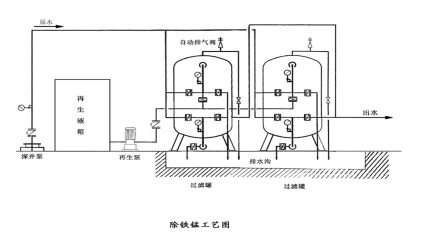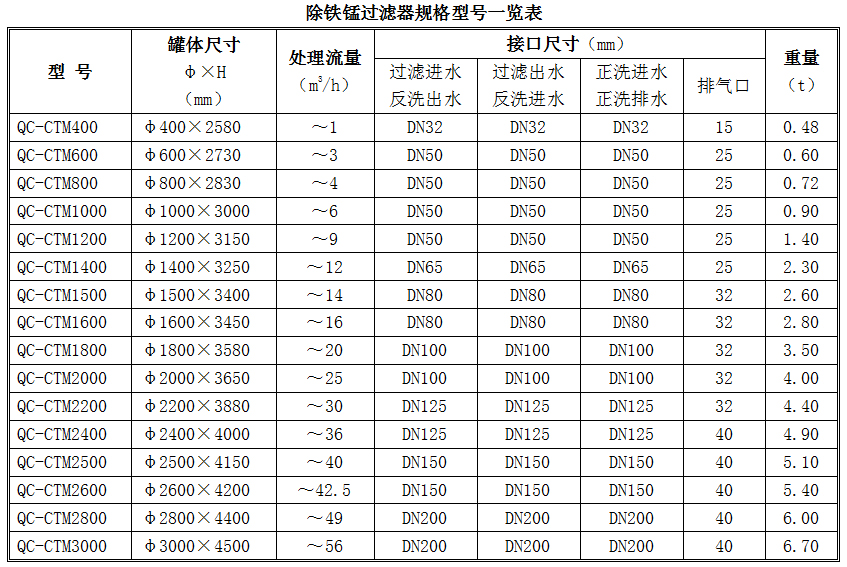one. Product Features
iron-manganese filter is mainly used to remove iron-manganese substances in the system and purify water quality; it can also be used for water decolorization, deodorization, etc.
two. Scope of application
It is used in food, beverage, papermaking, brewing industry, treatment of water containing excessive iron, groundwater, well water as drinking water for iron removal, geothermal engineering and swimming pool circulating water needs.
three. Features
1. The unique multi-filter chamber structure can realize online backwashing (filtering, draining and backwashing at the same time).
2. Power saving: The effluent is directly supplied to the pipe network, without the need for a secondary water supply system; it has its own backwashing function, and there is no need for another backwashing pump.
3. Water saving: This equipment adopts a "plum-style water distributor" to shorten the distance between the filter layer and the water distribution pipe, which can save a lot of backwashing water.
Four. technical parameter
1. Treatment effect:
①Iron content: ≤0.3mg/L;
②Manganese content: ≤0.1mg/L;
③The turbidity of the effluent: <3FTU.
2. Water inlet requirements:
①Iron content: ≤20mg/L;
②Manganese content: ≤3mg/L;
③Influent turbidity: <20FTU;
④Alkalinity: ≤2mg/L;
⑤pH value:> 6.0 (when removing iron),> 7.5 (when removing manganese).
3. Working environment parameters
①Working temperature: 5-60℃ (special temperature can be customized);
②Working pressure: ≤0.6MPa.
4. Operating parameters
①Working method: pressure type;
②Operation mode: water flow from top to bottom, series (high iron and manganese content) or parallel;
③Filtration speed: 6-10m/h (when removing iron), 5-8m/h (when removing manganese);
④Operation cycle: depending on the quality of the raw water, the minimum is not less than 8 hours;
⑤Backwashing method: water washing, or air-water combined backwashing;
⑥Backwash time: 10-15min;
⑦ Water consumption for backwashing: 1-3%;
⑧Backwash intensity: 15-20L/s·m2.
five. working principle
The iron and manganese removal filter is composed of an aeration device and a manganese sand filter tank; the low-valent iron and low-valent manganese ions in the water are oxidized to high-valent iron and high-valent manganese ions by oxidation, and then removed by absorption and filtration to reduce iron in the water. Manganese content.
1. Process flow
aeration → contact oxidation → adsorption filtration → backwash

2. working process
①Aeration
According to the water quality, it adopts deep well water residual pressure jet aeration or compressed air aeration, etc. The pipeline is mixed with dissolved oxygen, which is stable and reliable. On the one hand, the aeration method is to increase the dissolved oxygen in the water; on the other hand, it is to drive off CO2 to increase the PH value of the water and oxidize the divalent iron to precipitate trivalent iron, which is then filtered.
②Contact oxidation
The filter material adopts natural manganese sand filter material, which has a double layer effect of catalysis and filtration.
The main component of natural manganese sand is manganese dioxide (Mno2), which is a good catalyst for oxidizing Fe2+ to Fe3+.
When the PH value of iron-bearing groundwater is> 5.5, Fe3+ can be oxidized to Fe3+ when it comes in contact with natural manganese sand. The reaction is as follows:
A.4MnO2+3O2=2Mn2O7 b.Mn2O7+6Fe2++3H2O=2MnO2+6Fe3++6OH-
The Fe3+ generated is immediately hydrolyzed into flocculent iron hydroxide precipitation: Fe3++3OH-=Fe(OH)3↓
③Adsorption filtration
A. The flocs (Fe(OH)3 precipitate) formed by removing Fe3+ after the manganese sand filter layer;
B. Most of the unoxidized Fe2+ catalyzes the oxidation and the ion exchange of the oxidation of hydroxyl groups to remove iron.
The iron removal mechanism of manganese sand not only relies on its own catalysis, but also gradually forms a layer of iron filter membrane on the surface of the manganese sand filter material as an active filter membrane during filtration, which can play a catalytic role. The newly generated iron oxyhydroxide as the active filter membrane material participates in the new catalytic iron removal process, so the active filter membrane iron removal process is an autocatalytic process.
The principle of manganese removal is the same as that of divalent iron.
④Backwash
The system can adopt manual and automatic control methods. It is required to periodically backwash the manganese sand to remove impurities such as suspended solids that may be intercepted, and to loosen the manganese sand and the cushion at the same time. Since the filter is equipped with a backwashing device, there is no need to equip a backwashing water pump.
six. Specifications and dimensions
1. Dimensions
 2. List of specifications and models
2. List of specifications and models

 3. Model Description
3. Model Description


seven. Selection instructions
1. Equipment selection
①. The user needs to provide water quality report, use, automation requirements, machine room size and other parameters to facilitate the selection and selection of equipment and filter materials; for items that affect the effect of iron and manganese removal, such as: iron, manganese, total alkalinity, silica , Total hardness, ammonia nitrogen and other indicators must be emphatically inspected.
②. The process flow for removing iron and manganese should be determined according to the following conditions:
A. When: PH>6, iron content ≤10mg/L, or manganese content ≤0.5mg/L,-single-stage treatment;
B. When: PH>6, iron content is 10-20mg/L,-double tandem stage treatment;
C. When: both iron and manganese are contained, and the iron content is ≤2.0mg/l, the manganese content is ≤1.0mg/l,-single-stage iron and manganese removal;
D. When: both iron and manganese are contained, and the content exceeds the above-mentioned value, it shall be determined by experiment, removing iron in the first stage and removing manganese in the second;
E. When: both iron and manganese are contained, and the iron removal is affected by silicate, it shall be determined by experiment, two-stage aeration, one-stage iron removal and second manganese removal;
F. When: PH=5.5-6.0, iron content ≤5mg/L,-single-stage treatment, but water quality stability pretreatment is required;
G. When: PH<5.5 or iron content>20mg/L, or high iron and manganese content, the process flow must be determined according to the water quality.
③The pH value of the water before filtration of the manganese removal filter should be above 7.5, and the iron content of the water before the second filtration of the manganese removal filter should be controlled below 0.5mg/L.
- Previous Article: No Record
- Next Article: Fluoride filter